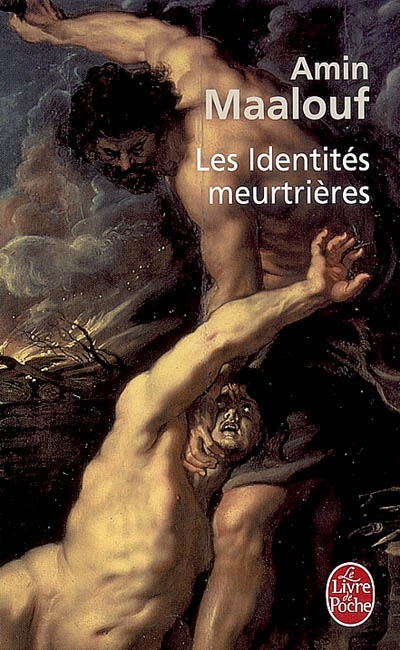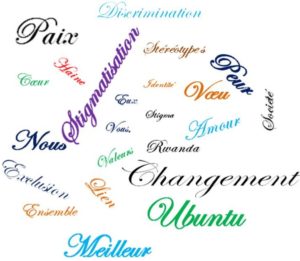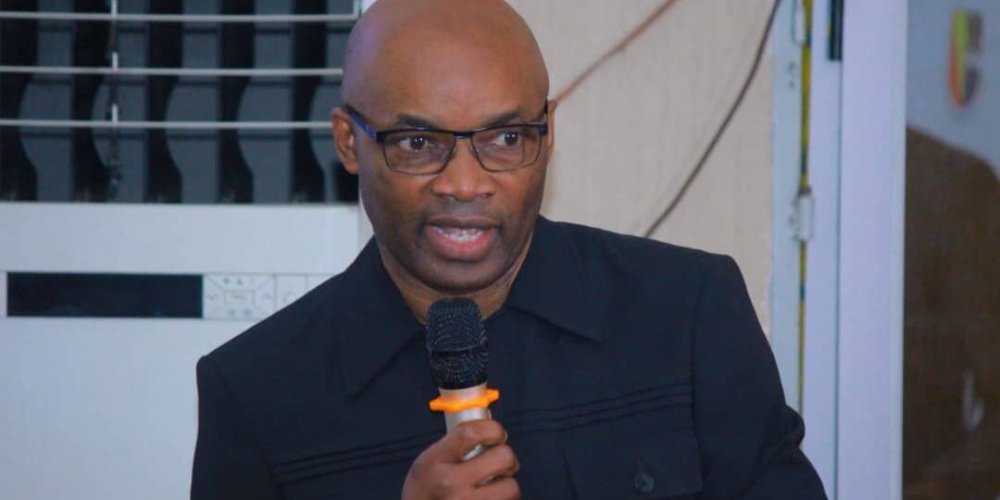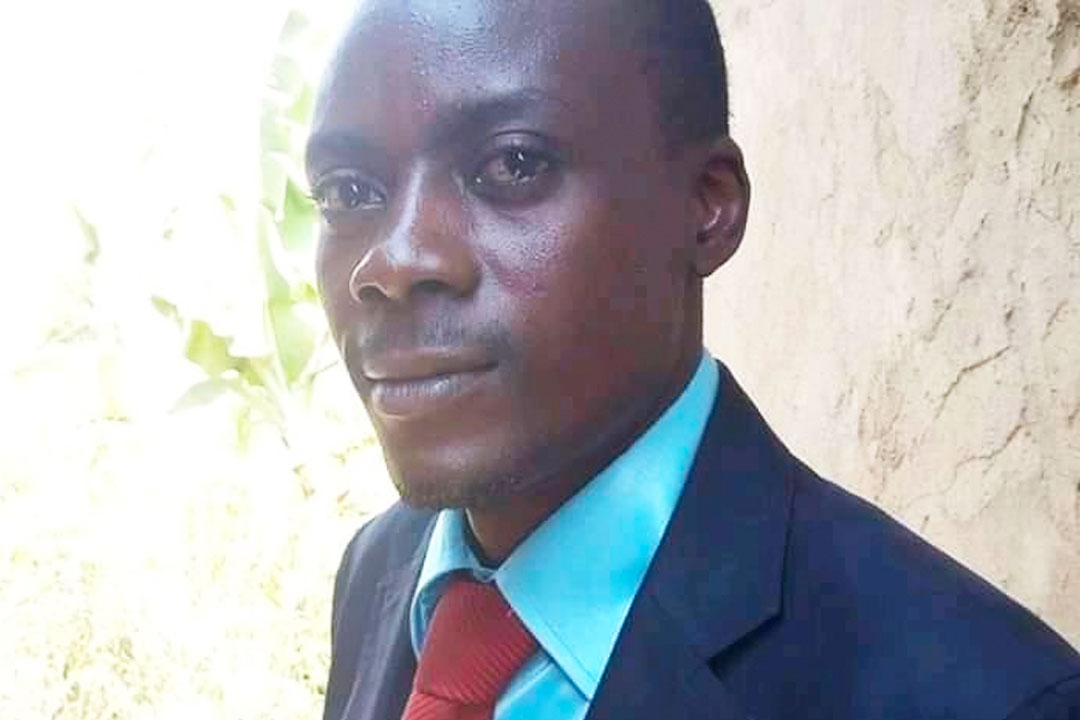Opinion article submitted by Constance Mutimukeye
“A lifetime of writing taught me to be wary of words. Those who appear to be the clearest are often the most treacherous. One of these false friends is precisely “identity”. We all think we know what that word means, and we continue to trust him even when, insidiously, he begins to say the opposite. “[1]This sentence by Amin Maalouf summarizes the subject of this article. These words used in everyday language, these simple and harmless words or expressions whose impact on others can be devastating. In Rwandan society, marked by ethnic divisions and deep wounds, the misuse of words often leads to the stigmatization of an entire section of society.
In November 2018, on the social network Facebook, seven people discussed the genocide against Tutsi in Rwanda in 1994. The exchange included more than 80 comments and covered several topics, including the designationof the perpetrators of this genocide and the role stigmatization played in Rwanda’s recent tragedies. This article summarizes some of these exchanges. The article is based on the interventions of four Rwandans with different experiences and backgrounds, the four individuals reached a common consensus at the end of the discussion: Rwanda’s past should lead Rwandans to be the world leaders in the fight against stigma. All the exchanges are attached to this article. The choice was made to anonymize the contributions to focus on the content of the exchanges and not on the participants in the discussion. In a future article, we will discuss the issue of stigmatization and its consequences in Rwanda after 1994.

Stigma in History and its consequences
From 7 April to 4 July 1994, in the space of 100 days, more than 800,000 people were murdered in Rwanda because of their Tutsi ethnicity and others because they were rightly or wrongly considered partners of the RPF. For several years the media and the United Nations have used the term “Rwandan genocide” which has tended to create controversy or confusion, even among Rwandans themselves. Indeed, the term was imprecise, vague and could suggest that people had been killed because of their Rwandan nationality. It took till 26 January 2018 that, at Rwanda’s request, the United Nations General Assembly clarified the terminology by referring to “the 1994 Genocide against the Tutsi in Rwanda, recalling that Hutu and others who opposed the genocide were also killed”.
The particularity of this genocide lies in its magnitude, with more than 800,000 deaths in 100 days, “a rate of execution four times higher than that recorded at the height of the Nazi Holocaust“[2].
It is also referred to as closeness genocide because Tutsi were persecuted, hunted down and killed by people they knew and over a large part of Rwandan territory. This genocide was characterized by the participation of civilians in the killings. The ICTR referred to them as being “ordinary citizens“3. One of the participants said that “The difference between the genocide against Tutsi and other genocides that could have occurred in other parts of the world is that, although the killers were supported by politicians, soldiers and militias, the killings were committed by civilians who were not necessarily affiliated with a political group. Tutsi were murdered by their neighbours, friends and, in some cases, relatives”. [Editor’s note: In the following paragraphs, the passages in italics are excerpts from the comments of the various participants in the discussion.]
So, it is a question of understanding of how ordinary citizens resigned themselves to eliminating their fellow human beings, those who were their friends, their neighbours on the sole grounds that they were not of the same ethnic group. “There have been crises in many countries but not in all these countries have people been killed simply because of their ethnicity or what was perceived as an ethnic group.»

“In the name of identity” is an essay written by Amin Maalouf. It questions the notion of identity and the conflicts it can cause. This book has been the inspiration for this article.
Rwandan society may appear to have been divided for a long time and have associated membership of political groups into identity categories. Thus, between the 1960s and 1990s, whenever groups composed mainly of Tutsi refugees carried out attacks on Rwanda, Tutsi within Rwanda would be likened to the attackers. The Tutsi in Rwanda were persecuted, many of them being killed or driven from their homes. Similarly, in 1973, in response to a massive influx of refugees from Burundi, mainly Hutu fleeing crimes committed against them by the government in Burundi, Tutsi living in Rwanda were targeted. Many Tutsi were killed and many others were forced to leave their jobs, schools and homes to find refuge abroad. They were associated with the predominantly Tutsi power in Burundi, which was responsible for these crimes against Burundian Hutu refugees in Rwanda.
Some of the Rwandans also lived in exile, deprived of their country. They engaged in struggles to acquire their right to their homeland. The subject here is not to decide on the legitimacy of the various attacks on Rwanda but on their consequences on Tutsi within the country. As early as the 1960s, writes one participant “Tutsi within Rwanda had concerns whenever an attack of Rwandan refugees in neighbouring countries was carried out on the country. Many had absolutely no connection with those leading these incursions into Rwanda’s territory and yet feared reprisals when the climate became tense, simply because they shared the same ethnic group as the assailants“. In this context, it was unusual to persecute Tutsi within Rwanda.
The peak of stigmatization was in 1990 after the attack of the RPA in the north of the country. Tutsi within Rwanda were gradually represented as associates to attackers from outside. To them were added all Rwandans, without distinction of ethnic groups, who were supporters of the RPF and those who were labelled as alleged partners of the RPF. People in these categories were identified in people’s minds as the enemies of the country. Rwanda was marked for 4 years by political assassinations, crimes and verbal, sometimes physical, violence in a context of civil war. From 1992 onwards, when, under pressure from France, the regime of that time was forced to open up the political space, several political parties were created. Gradually, with global indifference, making hateful, dehumanizing statements against Tutsi was trivialized. Rwandan society, for example, did not collectively take exception to the media that broadcast these hate speeches. Politicians engaged in political speeches that increasingly fostered a climate of fear among the population, resulting in a climate of hatred against Tutsi associated with the enemy. One example of the propaganda of hatred and fear of the other is the publication by the newspaper Kangura in December 1990 of the “Ten Commandments of the Hutu”, which required the Hutu to have an awareness of their ethnicity. Although the Ten Commandments were considered a “scandal” by Rwandans according to Marcel Kabanda, an ICTR prosecution expert in the so-called media case, the stigmatization and fear of the other were being spread. Amin Maalouf points out that instrumental fear linked to an identity necessarily generates a feeling of strong belonging to that identity and the perception of the other identity as the culprit to be eliminated. “For those who are directly involved in these identity conflicts, for those who have suffered, for those who are afraid, there is simply “us” and “them”, the insult and reparation, nothing else! “We” are necessarily, and by definition, innocent victims, and “they” are necessarily guilty, guilty for a long time, and whatever they can endure now“[3].
The idea here is to try to understand and contextualize why ordinary citizens have turned into killers. “The vast majority of these people committed genocide in the chaos of April 1994 because they associated all Tutsi without distinction, including women, the elderly and babies, with any partyidentified as the country’s enemy (and therefore a danger to them), namely the RPF which had attacked the country on 1 October 1990 and committed atrocities that caused the displacement of 1/7 of the country’s inhabitants”. Of course, no context can justify or excuse the fact that genocide has occurred. It is obvious that there is not a single answer that can suit everyone.
How to designate the perpetrators of the Genocide

If the victims of the genocide perpetrated against the Tutsi in Rwanda in 1994 are mainly Tutsi, can we say that their executioners are Hutu? Here again in the aftermath of the genocide, the perpetrators were usually referred to as “Hutu who massacred the Tutsi” by the media or in everyday language, or as executioners who “acted in the name of their Hutu identity”. This terminology is systematically controversial in Rwandan society. Some feel stigmatized, which others in turn perceive as a headlong rush or a form of denial of the genocide. By discussing the example of an ordinary Hutu citizen, described by a relative of his victims as “good” and “sweet” before the genocide but who turned into a genocidaire overnight by donning “his Hutu hat“, one of the participants wondered why his Hutu identity should be put forward to explain his act when, on the other hand, for an ordinary Hutu citizen who has saved lives, only his name, or even another identity, should be used to refer to his heroic act. Félicité Niyitegeka, for example, distinguished herself by her heroism during the genocide, but she is often portrayed by the media as “a Catholic sister“, her religious identity being the one put forward to explain her behaviour. “How is she more or less Hutu, than this ordinary citizen who killed his neighbours?”
But for this participant, “any genocidaire is the same person the day before and the day after the killings (with his qualities and flaws), except that at the time of the genocide, he decided that the ”Hutu” was threatened by the Tutsi. Saying that in Rwanda it was the Hutu who killed the Tutsi does not make the word ”Hutu” an identity of killers. It is just a matter of stating WHO did WHAT at a given place and time. In Rwanda, in April 1994, Mr. Hyde went out as a Hutu. But he also went out as a Muslim against Christians in some places in the world, Shia against Sunnis in the Muslim world, protesting against Catholics in Ireland. “[Editor’s note: Amin Maalouf defines M Hyde[4]: “one has to simply review the events of recent years to note that any human community, if it feels humiliated or threatened in its existence, will tend to produce killers, who will commit the worst atrocities by being convinced that they are within their rights, that they deserve heaven and the admiration of their relatives. In each of us there is a M Hyde; the whole thing is to prevent the conditions for the emergence of the monster from being met.”]
“Why should the Hutu identity (taken to its extreme) be used as an explanation for this criminal behaviour, whereas when it comes to positive, even heroic acts (such as saving lives sometimes at the risk of one’s own), the answer would necessarily have to be found in another identity that has taken over, whereas the Hutu who saved Tutsi, sometimes at the risk of their lives, are also counted by tens of thousands?” Repeated the first one.
The other term often used to refer to perpetrators is “Hutu extremists”. Without unanimity, this term has the merit of nuancing and not putting all Hutu in the same category. Those who use this term argue that it is primarily to highlight how far extremist ideas can go, and the importance of fighting these same extremist or hate-based ideas. “When we focus on the genocide perpetrated against Tutsi, it is not always to ignore the other realities of our history (which have also claimed the lives of many of our compatriots), but to mark its importance, to remind us that our hate speech, the dehumanization of some of our compatriots, the marginalization or discrimination of some groups, political propaganda aimed at attacking some people and all those other things that we do consciously or unconsciously, can lead our dear country to the same or worse result. Never again.”
At the end of one of its largest trials, that of military officials, the ICTR defined the perpetrators of the genocide as “Soldiers, gendarmes, politicians, Interahamwe and ordinary citizens were amongst the perpetrators”2, while specifying that not all members of the groups mentioned had committed the genocide. By this definition, the ICTR refrains from making any reference to the ethnicity of the perpetrators of the genocide.
But this answer was not suitable for all participants in the exchange. “On the one hand, can we imagine a typical Rwandan having to learn this long and complex sentence defined by the ICTR to describe what happened in his country?” asks one participant. “On the other hand, the difficulty of finding a term that does not stigmatize all members of any party or ethnic group lies in the diverse origin of the killers.” No designation was unanimously agreed upon at the end of the exchange, but everyone agreed that Rwanda should one day appropriate its history and propose a unifying term.
Ways to combat stigmatization in Rwandan society

One of the elements that emerged from the discussion was that two individuals speaking on the same subject, especially in writing, may mean the same substance but not understand the same thing because of the words used.
Some definitions of the words commonly used in the context of Rwandan history were proposed by one of the participants:
Hutu, Tutsi or Twa extremists:
“Starting from the definition of extremism, we can understand that talking about Hutu extremists does not mean “extremists with a Hutu tendency”, but rather Hutu with an extremist tendency. This means that the danger is not to be Hutu, or Hutu inclined (if there is one), but to be extremist. It is also understandable that extremism is not only found among the Hutu. We can also see it among the Tutsi but perhaps also among the Twa. »
Chauvinism:
“Chauvinism is an excessive manifestation of patriotism or nationalism. It reflects an exaggerated or too exclusive admiration of one’s country. “Applied to the Rwandan context, it may reflect the ideology of some Rwandans:
- When Hutu extremists said that Tutsi should return home to Abyssinia, it was chauvinism.
- When the Kayibanda and Habyarimana regimes did not care about Rwandans who had taken refuge abroad, it was chauvinism.
- When we call some Rwandans enemies of their own country, sometimes it is chauvinism.
- When some Rwandans are told that in order to be accepted in their country, they must behave in a certain way that is acceptable to the other group, this is chauvinism.
Militant:
“What differentiates an extremist from an activist is active participation or action. We can fight for good causes just as we can fight for bad causes. But even those who campaign for good causes sometimes use force or violence to advance their cause. So in 1994 during the genocide against the Tutsi, there were Hutu extremists who did not participate (I would say actively) in the genocide, for different reasons, good or otherwise”.
Survivor:
“A survivor is a person who has safely emerged from danger, disaster or threat.” In the Rwandan context there may be several types of survivors. When talking about a survivor, it is important to specify the danger from which he or she was rescued”.

Other points of agreement for a Rwanda where the foundations of peace will be solid are:
- Combat any ideology of hatred or extremism
- Fighting extremists on all sides
- Avoid stigmatizing or criminalizing an entire group
- Do not let yourself be locked into the logic of US against THEM
By agreeing that “we do not solve a problem with the ways of thinking that generated it“, the consensus emerged that we should not wait for change to come from others, or for change to come from the top to begin the process, but that each Rwandan who is convinced that living together must triumph over divisions, that we must accept others without asking them to reflect the image we have of them, can initiate the change by being the image of this desired Rwanda.
The conclusion of these exchanges was that after experiencing the worst of stigmatization on several occasions in our recent history, we Rwandans should be “at the global forefront of this fight against stigmatization on the basis of identity”, and we have a duty to “condemn evil, extremism, violence… Rwanda needs all of us. »
To discover all the exchanges between the 4 participants: click here
This article is translated from French

Constance Mutimukeye
Jambonews.net
[1]Amin Maalouf, Les identités meurtrières, Grasset, Paris, 1998, p. 17
[2]http://unictr.irmct.org/en/genocide
[3]Amin Maalouf, Les identités meurtrières, Grasset, Paris, 1998, p. 46
[4]Amin Maalouf, Les identités meurtrières, Grasset, Paris, 1998, p. 39 et 40





